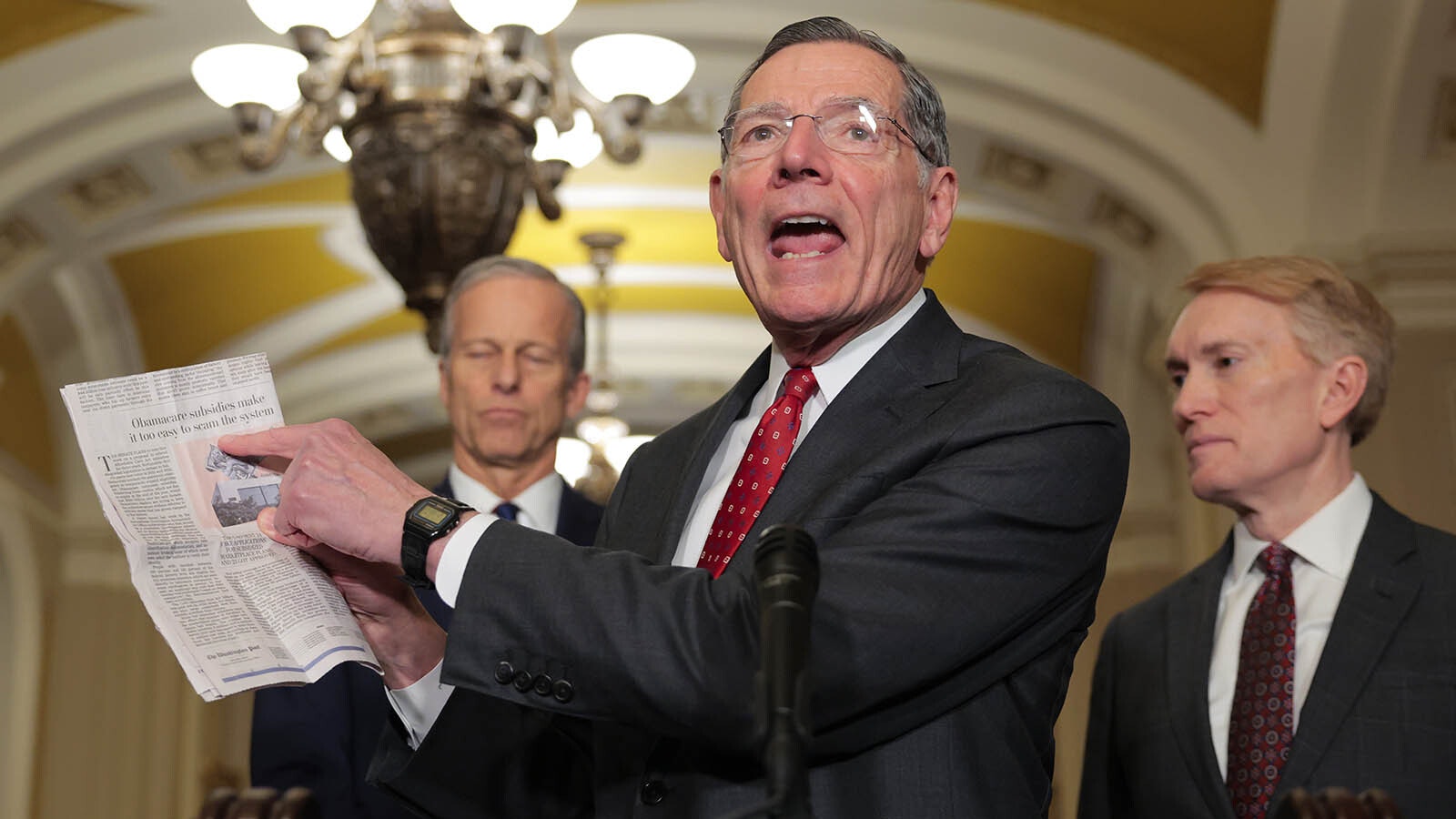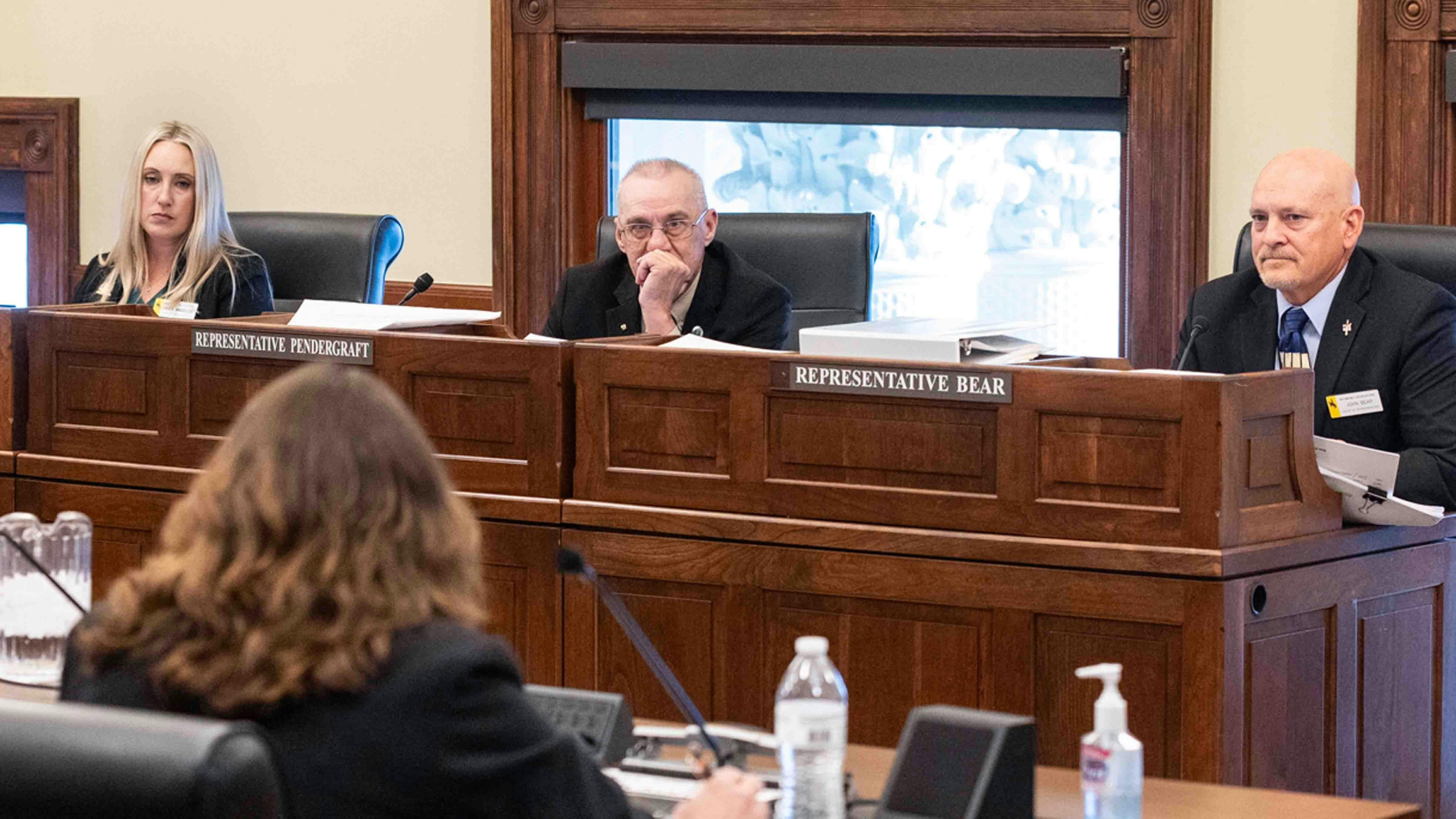Multiple Wyoming school districts say the repeal of Wyoming’s gun-free zones has prompted hikes in their liability insurance costs.
To detractors of House Bill 172, the 2025 bill criminalizing people who try to block lawful concealed-weapons carriers from public areas like school events, the insurance hikes are a third-party testament to the risks associated with the new law.
The bill’s proponents, conversely, pondered aloud whether insurance companies are just being “punitive.”
The topic surfaced repeatedly Tuesday and Wednesday at a Casper meeting of the Select Committee on School Finance Recalibration.
It started when the business manager of Teton County School District No. 1, Kristen Mayo, said the district had to buy a $35,000 rider because of the introduction of conceal carry at school.
State House Speaker Chip Neiman, R-Hulett, voiced surprise at this, saying, “Up ’til now, our laws only kept out law-abiding gun owners.”
Mayo countered.
“It’s really a difference between passing legislation intended to benefit the community versus the real-life issue of how an insurance company is going to look at that,” she said. “In order to renew our liability insurance this is what we have to do.”
Mayo later clarified that the district’s overall liability insurance sits at more than $500,000, which renders the rate hike less noticeable, some attendees said.
House Bill 172 designates school districts and numerous other public areas as conceal-carry permissible areas.
Anyone who knowingly blocks a permitted carrier from entering such a place could face a criminal penalty of up to one year in jail and a fine of $2,000 under the law, which takes effect July 1.
School districts “may” pass policies governing carry criteria for their own employees and volunteers.
The bill doesn’t speak to whether school districts can vet other event entrants to ensure they are, in fact, lawfully carrying.

Eight Years Of Feeling This
Uinta County School District No. 1 has been feeling the rate hikes from conceal-carry permissions for about eight years, John Williams, chief financial officer for the district, told the committee Wednesday.
That district was the first in the state to opt into a conceal carry policy for its staff, in 2017.
Its then policy-carrier HUB International declined to insure the district, said Williams. Other carriers also bailed, he added.
“It started to just limit the number of carriers,” he said, adding that eventually, the district selected Lloyd’s of London.
Insurance rates have been on the rise for years regardless, said Williams, from $120,000 three or four years ago to $180,000.
The district bought a rider for $16,000 to account for its concealed-carrying employees after passing its standalone policy. It’s looking at another $32,000 in light of the new state law, Williams confirmed under the questioning of State Rep. Mike Yin, D-Jackson.
Not Everyone
The School Risk Retention Program (SRRP), an insurance pool administered by the Wyoming School Boards Association in which many school districts participate has taken the position that the new law shouldn’t change its coverage, association Executive Director Brian Farmer told the committee.
SRRP’s joint powers board determined there’s not a pressing additional risk requiring added costs, Farmer said.
“However, in the national market, it is something (on which) the national carriers have been less willing to tolerate that risk,” he said.
Cybersecurity and other new risks have also driven insurance needs up recently, Farmer added.
He’d referenced in passing the Columbine and Sandy Hook school shootings, and how an event like that could lead to massive financial fallout and litigation.
“The two mass casualties you mention both happened in gun free zones — and one (in a jurisdiction) with an assault weapons ban,” Rep. Tom Kelly, R-Sheridan, told Farmer.
It was an echo of the rationale many of the bill’s proponents voiced this year during its formation: that the presence of more guns make for a safer campus.
Farmer said he couldn’t speak to those dynamics, but attested that insurance companies are weighing “overall risk.”
Williams had referenced a lighter gun-risk issue: what happens when a staffer accidentally shoots a toilet.
In another portion of the meeting, Kelly called the rate hikes “almost punitive.”
Lander Says Nah
Fremont County School District No. 1 in Lander passed its conceal carry policy in 2019.
That didn’t increase its insurance, the district’s Board Chairman Jared Kail told Cowboy State Daily on Thursday.
He directed Cowboy State Daily to the district’s business manager for more information, but the latter did not return an email by publication time.
Insurance Company Reasoning
Multiple other districts told Cowboy State Daily they’re seeing an increase.
Fremont County School District 25 in Riverton received a recommendation for a $10,000 to $11,000 “active assailant” policy addition from its insurance company, Tegeler & Associates, Superintendent Jodi Ibach wrote in a Thursday email.
The Riverton district had briefly considered a conceal carry policy prior to the new law’s passage, but didn’t pass one at that time.
Curt Paxton, manager of Tegeler’s Riverton office, said it’s about the grey areas of the law and the erosion of the school’s control over its own areas and events.
The school’s policymaking is limited to its own employees and volunteers under the law.
The new legal scenario “goes way past whether teachers can conceal carry or things like that,” said Paxton. “It’s the general public. A school zone cannot be a gun-free zone by the school’s design anymore.”
People can carry guns into school auditoriums, football games, volleyball games and track meets.
And school staffers “no longer have a control over that … being able to monitor whether people can bring guns or not, in those situations,” added Paxton.
Not Completely Surprised
Kelly told Cowboy State Daily on Thursday that he “wasn’t completely surprised” at the news of insurance increases, but is “trying to discern right now how much is due to real risk, how much is political — and how much is just because everyone’s liability insurance rates are going up in all cases.”
He doesn’t have those answers yet, he said. But he noted that when school budgets run in the millions of dollars, insurance increases in the low thousands are “a small part of (the school budget discussion) overall.”

Centralize!
To Yin, the insurance increases look like feedback.
“What I would say is, it’s still an external entity telling us there’s an increased risk with our policy change in the law,” said Yin. “My hypothesis (is that’s) more guns in schools just generally increase the risk of someone being hurt by a gun in school.”
In both the meeting and his interview, Yin suggested centralizing the districts’ insurance plans under one pool run by the state, reasoning that it’s the public’s money anyway.
He theorized the state pooling those rates and self-insuring could establish a better policy.
Dicky Shanor, chief of staff for the Wyoming Department of Education, didn’t take a stand on Yin’s suggestion but warned of pushback.
Throughout the years, school districts have resisted policies that take away their power to make decisions on a local board level, he said.
More, And More
Other schools responding to Cowboy State Daily inquiries spoke of their expected insurance increases.
Laramie County School District No. 1’s liability carrier, Glatfelter, told the district any gun injury would not be covered, so the district worked with a broker to get supplemental coverage for staff carry for about $28,000.
That figure could increase depending on the number of employees who choose to carry, LCSD1 spokesperson Brad White told Cowboy State Daily.
LCSD1, like many Wyoming schools, is working on its own carry policy to address the new law.
Natrona County School District 1 is reviewing a new policy.
The district “is currently looking into the various avenues for insurance, and we anticipate a rate hike,” Tanya Southerland, director of public relations, wrote in a Thursday email.
That district’s insurer is HUB International, she said.
Clair McFarland can be reached at clair@cowboystatedaily.com.





